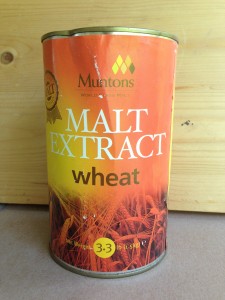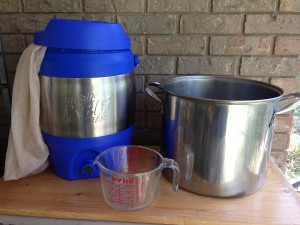
Malt extract is convenient and great for many beers. To brew very hoppy beers, however, you may need toalter your usual brewing techniques a bit
IPAs are all the rage these days. And stovetop extract brewers, of course, want to brew them and other hoppy beers. Although you can brew a fine extract IPA, there are some challenges that you must first overcome.
The standard practice for brewing stovetop extract beers — in the US, at least — is too steep some specialty grains, then boil a thick wort of dissolved malt extract in a stovetop brew pot. After the wort is boiled, it is cooled and diluted to working strength in the fermenter. Often, for a 5.0-gallon (19-L) batch of homebrew, around 2–3 gallons (8–11 L) of wort is boiled. This practice works well for many types of beers, but can cause problems if you are trying to brew a very hoppy ale.
The Challenges
The first problem, which is well-known, is that hop utilization decreases as wort gravity increases. You extract more bitterness from the hops when they are boiled at a lower specific gravity. Since stovetop extract beers are made by boiling a thick wort, this can limit their bitterness.
The second problem, which is under appreciated, is the dilution factor. If you boil 2.5 gallons (9.5 L) of wort in order to make a 5.0-gallon (19-L) batch, the boiled wort needs to have twice the IBUs as you intend your beer to have. For example, if you want to brew 5.0 gallons (19 L) of IPA at 70 IBU, and you end up with 2.5 gallons (9.5 L) of post-boil wort, that wort needs to be 140 IBU. And, the solubility of iso-alpha acids is such that the maximum IBUs a beer can have is in the 70 to 100 range. (The IBU rating on most commercial IPAs and double IPAs comes from a calculation, not a measurement.)
In general, use the CV = CV (concentration times volume) equation to see how many IBUs your thick wort would need to have to hit your target bitterness. For example, if you were brewing the same 5.0 gallons (19 L) of 70 IBU IPA, but this time your post-boil volume was 3.5 gallons (13 L), your required IBUs would be:
5.0 (70) = 3.5 (X)
X = 100, so your 3.5 gallons (13 L) of wort would need to have 100 IBU in order to be diluted to 5.0 gallons (19 L) at 70 IBU.
The final challenge is fermentability. Usually, all-grain worts are more fermentable than worts made from reconstituted malt extract. And IPAs and other hoppy beers tend to be on the dry side, to accentuate the hop character. In addition, some extract IPA recipes call for steeping large amounts of CaraPils, or other light crystal or caramel malts. This exacerbates the problem of fermentability, as these malts contribute unfermentable sugars to the wort.
The Solutions
An obvious solution to some of these problems is to simply to add more hops. And this works to a degree. You should always taste your beer, forget about what your recipe calculator says, and see if it tastes bitter enough. If it is lacking, the first remedy is to add more hops the next time you brew.
However, the more hops you add, the more wort gets lost to the “sludge” at the bottom of your brew pot. Adding hop extract can help you reach your target bitterness without adding more plant material to the boil. In addition to bumping up the amount of hops to add, there are other things you should do.
Boil as much wort as you can. The closer you get to a full-wort boil, the better. You can help your boil along by partially covering your brew pot with the lid, splitting the batch into multiple pots on your stovetop, or even producing the wort in shifts on consecutive days. Keeping the wort topped up with boiling water can help you boil for 60 minutes, but still have a post-wort boil volume near the maximum amount of wort you can boil.
Add half or more of the malt extract late in the boil, or at knockout. Withholding a portion of the mall extract and adding it near the end of the boil means that your wort gravity will be lower during the bulk of the boil. This will help with hop utilization.
Limit the amount of steeping grains in your recipe. Large amounts, over 0.50 lb. (>~0.25 kg) for a 5.0-gallon (19-L) batch, of light crystal or “CaraAnything” malts are not needed in IPAs. And in other hoppy beers, they will add too much body, detracting from the hop character.
Rewrite your recipe to include a partial mash. The wort from the partial mash will be higher in fermentability, and lower and color, than the reconstituted malt extract. You can also use the enzymes from the partial mash to increase the fermentability of the dissolved malt extract. My Roswell IPA recipe uses this technique. You can also increase the fermentability of an extract wort moderately by swapping 5 to 10% of the malt extract for table sugar (sucrose). The addition of a partial mash also helps the malt aroma of any extract beer.
Finally, don’t skimp on the late hops. Having plenty of hop flavor and aroma helps increase the perception of bitterness and a happy beer. And, adding a little bit of gypsum (calcium sulfate) to your wort — 2 or 3 tsp. for a 5-gallon (19-L) batch — may also help accentuate the hop bitterness, especially if your tap water is low in sulfates to begin with.
Conclusion
So, basically add more hops, boil a larger volume of wort, and do a partial mash. With these additions, you can keep (at least most of) the convenience of brewing with malt extract on your stovetop, yet still get the bitter beer you desire.
—
Related articles


Speak Your Mind